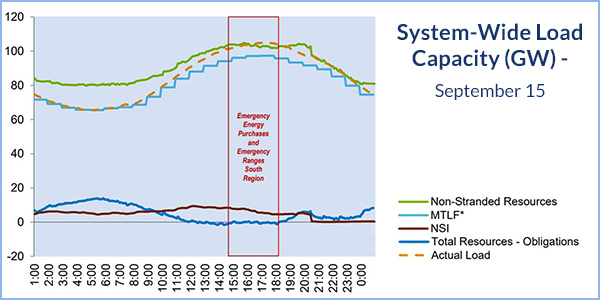By Amanda Durish Cook
Lessons from the Jan. 17 MISO South emergency resulted in smoother management of the Sept. 15 emergency in the region, RTO officials told stakeholders last week. MISO this week pledged more training and more vendor outreach during another post-mortem of last month’s emergency.
MISO had better awareness of its contract limit on SPP transmission linking its Midwest and South regions during the emergency, Senior Real Time Operations Engineer Steve Swan told the Reliability Subcommittee meeting Oct. 5.
The latest maximum generation event resulted in emergency purchases and public appeals to conserve energy. (See Emergency Ops, Calm Summer Top Talk at MISO Board Week.)
“Overall, performance that day between MISO and our joint parties was a lot better than the January maximum generation event,” Swan said, adding that the RTO communicated often with SPP about flows to South, which exceeded the 3,000-MW north-to-south sub-regional contract limit on the SPP line for about 15 minutes.
MISO is pledging to do more in time for the next emergency, including conducting drills on emergency purchases with external entities and continuing to work with SPP on managing the North-South contract path.
MISO analyst Dustin Grethen said the Sept. 15 emergency could probably have been helped by a reserve capacity product. The RTO hopes to complete a conceptual design of a short-term capacity reserve project by the end of the year or early 2019. It is developing a capacity product with a 30-minute ramp response time furnished by units that are both online and offline.
In September, MISO Executive Director of Market Development Jeff Bladen said that he expected the product to become “a very valuable part of MISO’s portfolio.” He said the 30-minute time span will be useful for system flexibility because wind forecasts become “very, very accurate” 30 minutes out.
Weather Forecasts
Swan said a missed weather forecast led to a 1.8-GW load forecast error in MISO South on Sept. 15. The RTO ultimately had to commit 1.1 GW above the day-ahead commitment for South after a 1.4-GW generator in the region unexpectedly tripped off late on Sept. 14.
“This is one of the worst days we’ve had for our load forecast error historically. It seemed to be a one-off,” Swan said.
The RTO was in “constant contact” with its two weather forecast vendors throughout the day of the emergency, Swan said. The vendors continued to stand by their afternoon forecasts hours before the emergency. However, hotter-than-expected weather materialized quickly, and an expected cloud cover never appeared.
After stakeholder questioning, Swan said MISO had “no reason to believe” that missed forecasts would become more common.
Some stakeholders argued that local meteorologists saw the extreme heat, asking MISO to include local forecasts in their weather predictions. We Energies’ Tony Jankowski asked the RTO to consider hiring an in-house meteorologist. However, RTO staff maintained that even local weather forecasters underestimated the heat that day. Staff said aggregate load forecasts from local balancing authorities were actually lower than MISO’s load forecast for the day.
Michigan Public Service Commission staffer Bonnie Janssen asked if MISO could work with the forecasting vendors more closely. She said it’s not uncommon for surrounding regions to experience unusual weather patterns as hurricanes make landfall. Hurricane Florence had arrived at North Carolina a day earlier on Sept. 14.
Swan said the RTO is continuing to work with the vendors on communication protocols.
2 LMRs Disqualified
Meanwhile, MISO disclosed that it had disqualified two load-modifying resources (LMRs) from providing capacity for the remainder of the 2017/18 planning year because of nonperformance during the mid-January emergency.
MISO analyst Scott Thompson said the LMRs had not updated their availability through the entire month of January or throughout the 2017 summer. They also did not respond to MISO’s scheduling instructions during the January event, nor did they participate in earlier LMR drills, he said.
“They weren’t making the effort to show up. They thought the capacity payment was good enough, but they didn’t hold up their end of the equation,” Thompson said.
FERC and NERC announced in early September that they would investigate the Jan. 17-18 cold snap and subsequent maximum generation alert for the South. (See FERC, NERC to Probe January Outages in MISO South.)
At an Oct. 4 Reliability Subcommittee meeting, Chris Miller, FERC’s liaison to MISO, reminded stakeholders that the commission’s action is simply an inquiry, not enforcement. Miller said MISO and other RTOs seemed to better handle communication during high temperatures this summer and severe weather from Florence.





